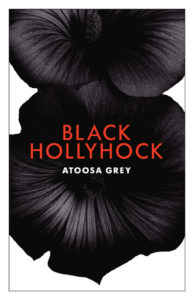
Review by Michelle Wilbert
– As I completed Atoosa Grey’s organically lush Black Hollyhock, I thought immediately of the nearly platonic ideal evoked by Mary Oliver in “Sometimes”: “Instructions for living a life: / Pay attention. / Be astonished. / Tell about it.” In Grey’s fine work, we are led through a robust yet gentle walk through the quotidian mysteries—the sacred and sublime that are always infused within the mundane by anyone willing to see and respond to them and then willing to allow into consciousness. Of course, to do that well, one must admit to “astonishment,” and Grey nimbly moves the reader towards that necessary sense of wonder—the platform for astonishment—that invites the reader to travel into play and to ask serious questions through a generous embrace of background and life experiences. Grey was born in Tehran, Iran and lives and works in Brooklyn, New York. She holds an MFA in Creative Writing from The New School, and her poems have been published in Right Hand Pointing, Best American Poetry blog, Mom Egg Review, Eunoia Review, Fat City Review, Mandala Review, and Common Ground Review.
The title poem, “Black Hollyhock,” refers to the painting by Georgia O’Keefe, and by way of a simple and poised observation invites continued inspection. The absence of ending punctuation leaves the reader to her own curiosity and to a desire to return to the painting to experience what William Blake called the “felt thought” that coexists between artist and observer:
More than half
the canvas is
sedated by the plump
expression of
the hollyhock,
the black paws gesturing
to the larkspur,
whose wisps of pink and green
signal from open-
mouthed clusters (20)
The poem allows the reader to feel relationship and dialogue, to sense the poet asking the questions, “What do you think? What do you see?”—a conversation that unfolds within shared contemplation. Grey’s poems evoke a clear sense of intimacy with self and others.
The poems are vigorous and straightforward and challenge the reader to engage with specters of real or potential trauma that may be unfamiliar. In “Shelter,” the liberal use of line breaks give one a visceral sense of the hesitancy and reluctance inherent in trying to share the experience of a woman and mother fearing violence:
Imagine going
from housewife
to squatter
in a cave
beneath your home
in the village of Kafr Lata
Imagine hanging
your clothes
between olive trees
in the mountains,
the mountains
you now call
neighborhood
the trees
you name
brother sister
You have tucked
home
behind your ear
behind these stones
you tuck children in
night after night
so the killers
can no longer
find you (3)
Once again, the poem enables the reader to continue the story imaginatively and to find, not answers, but deeper, more complex questions that may have no convenient resolution.
The poems generate their essential magic: the entire work seems to exist almost as a writing prompt for the reader—it digs into the subconscious, into history and experience in order to navigate unexplored emotional and spiritual territory to bring something unexpected and fresh in response.
None of this is to suggest Grey’s poems are shrouded in heavy darkness—not at all. There is a lightness here, communicating that life is just life and what comes to us is our particular vocation and vision all anchored securely within our hopes and concerns for our personal and collective evolution. There is an abundance of simple pleasure contained in many of the poems, including my personal favorite, “Encounters,” where the poet’s vivid imagery makes it possible to be with the moment as it unfolds and to awaken slumbering aspects of self:
The rooftop is
where birds gather
and withdraw their
shoulders from the sky.
They colonize the roof,
electrical wires, things
that face upwards more
than downwards. The half-dead
part of myself lifts
when I see them conversing
like grade school friends.
The hello between birds
and the rooftop is the hello
between the glint and their beaks
is the hello between my gaze
and their calls. Encounters
strung like beads,
like lashes on an eye. (17)
Atoosa Grey has written a beautiful first book of poetry that is an honor and a deep pleasure to read and respond to. She brings a unique, bold sense of truth, making the things of daily life shine with purpose, integrity, and beauty.
Black Hollyhock
by Atoosa Grey
Finishing Line Press $14.49 [paper]
ISBN 9781622299379
Michelle Wilbert is a writer, book reviewer, poemcatcher, spiritual director, wife, mother and retired midwife. She is the facilitator of The Coffee and Ink Writers Group, working toward her certification as a writing workshop leader with Amherst Writers and Artists.
